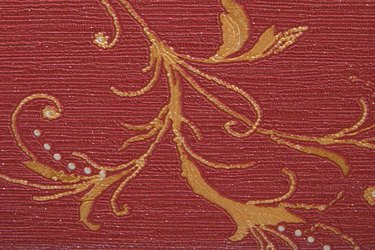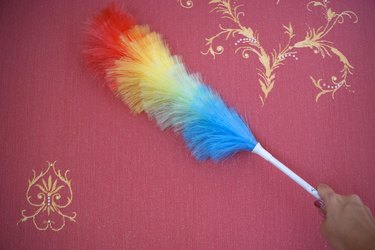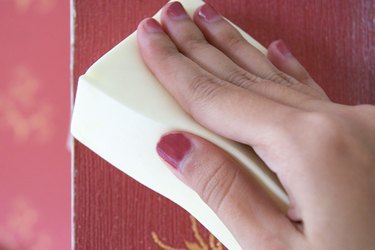
The walls in your home inevitably get dirty, whether they're painted, paneled or wallpapered. Washing walls is a big job and should be a regular part of deep cleaning your house once or twice a year. When it comes to cleaning wallpaper, it's important to know the type of paper you're working with so you won't damage the material. Fortunately, many types of modern wallpaper are designed for quick and easy cleaning.
Dust First
Video of the Day

Begin by removing the surface dust from the wallpaper. If you don't do this and start cleaning with liquid, the damp dust can cause a stain on the wallpaper. It's also a good way to remove cobwebs that might be lurking unnoticed in a dark corner. Remove any framed art hanging on the wall. Keep track of nails or screws by placing a small piece of tape over the hardware. Use a soft duster, such as a lamb's wool or electrostatic duster that draws dust and lint like a magnet. Many dry dusting tools come with extension handles that help you reach high places. You can also use the hose attachment with upholstery brush on a vacuum.
Video of the Day
Light Cleaning

Check with the manufacturer of your wallpaper to see what's safe and what is not recommended to use on the material. If you don't know what type of paper it is or who made it, test your cleaning solution in an inconspicuous place before proceeding. Vinyl wallpaper and vinyl coated wallpaper are typically the easiest types to clean. Mix a solution of warm water and a few squirts of mild dishwashing detergent. Dip a soft, white cloth or natural sponge in the cleaning solution, and then wring it out thoroughly so that it's slightly damp. Gently wipe the wall to remove dirt spots, smudges and fingerprints. Rinse the cloth or sponge in clean water, wring it out and wipe away any soapy residue. Follow that with a clean, dry cloth to remove remaining moisture.
Stubborn Stains

You may still find stains on your wallpaper that light cleaning did not remove. To remove stubborn stains from washable wallpaper, try denatured alcohol. Apply the alcohol with a paper towel and allow it to sit for 10 to 15 seconds. Then wipe it away with a clean paper towel. You may need to repeat this procedure a few times. For greasy stains, make a paste with baking soda and water. Apply the paste to the stain and allow it to dry. Gently brush away the dried powder, being careful not to scratch the wallpaper's surface.
Dry Cleaning

Plain paper wallpaper and some fabric wallpapers can be damaged by moisture. For nonwashable wallpaper and leftover stains on washable paper, use a dry cleaning chemical sponge. Although the name implies a chemically treated material, dry cleaning sponges are actually made from an all-natural vulcanized latex rubber. These sponges absorb soot and smoke stains as well as dirt and grime, and even pick up pet hair. When the surface of the sponge becomes clogged with dirt and debris, remove the outer layer of the sponge with a razor blade to expose a fresh surface underneath. As always, test the sponge in an inconspicuous area first.
What to Avoid

Never use any type of cleaner with harsh abrasives or granules, or products containing bleach, on wallpaper. These materials can scratch or mar the surface of the wallpaper. Bleach can discolor the material. Don't use colored sponges, which can leave traces of dye on light-colored wallpaper. Never use trisodium phosphate on wallpaper, because this product is actually used to remove wallpaper and its adhesive.